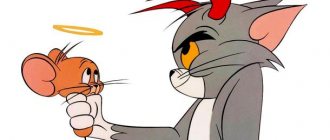The Function of Gaze: Cultural and Historical Significance in Society
The manner of looking is of great importance during communication. But representatives of different cultures have their own etiquette regarding the permissibility and appropriateness of direct eye contact. Thus, in Western European countries it is customary to look long and intently, expressing trust and interest in the conversation. A similar tradition is common in Russia and other CIS countries.
Residents of the Far East regard an attempt to make eye contact as disrespect and even a threat. This is especially pronounced in Japan: during a conversation, the Japanese specifically look to the side so as not to accidentally look at the interlocutor. When studying the culture of views, one should take into account national characteristics, otherwise one can misjudge intentions and provoke a quarrel.
Brows.
I also see it in the eyes and in the eyebrows. The eyebrows follow the emotions of the eyes, as if there is a string between them. Some eyebrow movements have already been discussed above. The bottom line is that moving eyebrows indicate that there is emotion towards you, while stationary eyebrows indicate that you are not arousing real emotions in the person. Different emotions, positive or negative, eyebrows in motion. If there is indifference and indifference, the eyebrows do not move.
You need to take into account many factors, facial expressions and body movements. This is difficult, because each person is individual and may have his own gestures, which need to be interpreted individually, knowing him personally and well. I see the expression in your eyes will add persuasiveness to your words if you can provide more pressing evidence. Therefore, good luck to you and your friends in studying this fascinating phenomenon - the gaze!!!
See useful articles below.
What does the size of the pupils indicate: what is the interlocutor hiding?
During a conversation, the size of the pupils may change dramatically. This is due to the emotional attitude towards the interlocutor or the subject of conversation. Dilated pupils are a sign of strong emotional upsurge: the partner is looking at what he likes. This is how lovers look at the object of their passion or children look at a desired toy. Constricted pupils are a sign of detachment and emotional coldness.
When assessing pupil size, it is important to take into account third-party factors. So, in bright light, the pupils narrow greatly, and in semi-darkness they dilate. Some diseases, for example, increased intracranial pressure, can affect the width of the pupils.
Health status
Even some diseases can be determined by the condition of the eyes. For example, yellowish whites of the eyes indicate liver problems. In addition, research by scientists has shown that people with different eye colors are prone to different diseases. For example, those with brown eyes should be wary of diseases of the digestive tract; blue – asthma, arthritis, rheumatism, stomach ulcers. Green-eyed people often have increased toxicity and acidity associated with the functioning of the nervous and digestive systems.
Gaze frequency and duration: how to understand signals
The duration of looking at a partner within European culture has different meanings, depending on the nature of communication. The following types of views are distinguished:
- Social - medium duration, aimed at the eye or mouth area.
- Business - direct, long-lasting, expresses the desire to reach an agreement.
- Intimate - intermittent for women, long-lasting for men. Used to attract the attention of an interested person.
A direct gaze directed downwards at a partner is a signal of threat, a warning of an attack. This is how dominant individuals look, seeking to assert their position. In friendly and business communication, a challenging gaze should be avoided so as not to accidentally provoke aggression.
List No. 1
- adventurous
- aggressive
- adequate
- gambling
- greedy
- angelic
- apathetic
- womanish
- babkin
- grandma's
- mutton
- lordly
- daddy
- father
- vigilant
- fluent
- shameless
- fearless
- thoughtless
- soulless
- ruthless
- lifeless
- carefree
- bottomless
- defenseless
- good-natured
- serene
- hopeless
- joyless
- indifferent
- reckless
- insane
- indifferent
- endless
- careless
- restless
- nonsensical
- fearless
- shameless
- shameless
- artless
- insensitive
- mad
- reverent
- grateful
- benevolent
- blissful
- myopic
- lascivious
- wandering
- cheerful
- painful
- sick
- timid
- squeamish
- brutal
- violent
- rebellious
- fast
- bullish
- vampire
- inspired
- thoughtful
- witchy
- fabulous
- stately
- treacherous
- funny
- cheerful
- windy
- mutual
- guilty
- wet
- domineering
- sane
- sudden
- attentive
- coveted
- warlike
- wolfish
- interrogative
- thievish
- inflamed
- enthusiastic
- delighted
- hostile
- hostile-cold
- counter
- corrosive
- expectant
- defiant
- expressive
- arrogant
- lethargic
- squeamish
- heroic
- heroin
- disastrous
- hypnotic
- hypnotistic
- deep
- mocking
- silly
- silly
- angry
- depressing
- Hollywood
- dizzy
- hungry
- proud
- proud
- sorrowful
- hot
- master's
- sinful
- formidable
- rude
- sad
- hussar
- farsighted
- maiden
- girly
- grandfatherly
- duty
- delicate
- demonic
- depressive
- bold
- children's
- wild
- savage
- wild
- long
- Kind
- kindest
- good-natured
- friendly
- confiding
- long-awaited
- annoying
- dramatic
- friendly
- bad
- diabolical
- unctuous
- greedy
- compassionate
- plaintive
- hot
- burning
- gall
- female
- hard
- cruel
- alive
- cheerful
- roguish
- creepy
- creepy
- caring
- envious
- envious
- mysterious
- pensive
- interested
- shy
- frozen
- animal
- brutal
- worst
- spiteful
- wicked
- sinister
- malevolent
- furious
- serpentine
- familiar
- famous
- sultry
- keen-sighted
- playful
- idiotic
- mocking
- exhausted
- amazed
- amazing
- ironic
- ironic
- inquisitive
- sincere
- frightened
- sour
- male
- insidious
- flirty
- witchcraft
- prickly
- barbed
- embarrassed
- short
- oblique
- feline
- nightmarish
- Beautiful
- eloquent
- crooked
- crystal
- crystal Clean
- bloodthirsty
- gentle
- servile
- affectionate
- legendary
- ice
- lazy
- false
- sticky
- fox
- dashing
- sly
- radiant
- radiant
- kind
- Darling
- curious
- curious
- loving
- cannibalistic
- fierce
- magical
- magnetic
- unpleasant
- boyish
- mom's
- momkin
- buttery
- maternal
- matushkin
- mellifluous
- melancholy
- vile
- dreamy
- Cute
- merciful
- gracious
- fleeting
- infant
- meaningful
- fulminant
- gloomy
- wise
- male
- turbid
- painful
- martyr
- rebellious
- observant
- intrusive
- impudent
- haughty
- bothersome
- didactic
- annoying
- naive
- tense
- freaky
- mocking
- persistent
- wary
- impudent
- non-aggressive
- inadequate
- not indifferent
- careless
- not impartial
- malevolent
- unfavorable
- sad
- unfaithful (that is, not believing, distrustful)
- innocent
- inattentive
- unperturbed
- involuntary
- unbearable
- inexpressive
- indignant
- unambiguous
- indelicate
- unkind
- incredulous
- dissatisfied
- unkind
- short-lived
- wakeful
- perplexed
- unfriendly
- unfriendly
- unfriendly
- gentle
- disinterested
- inconspicuous
- not from here
- frantic
- unkind
- awkward
- hated
- unobtrusive
- unobtrusive
- abnormal
- unusual
- unusual
- disapproving
- indescribable
- careless
- irresistible
- inseparable
- relentless
- unique
- fixed
- inappropriate
- disobedient
- unfriendly
- hostile
- unpleasant
- short-lived
- impenetrable
- partial
- unreal
- immodest
- timid
- unhappy
- impatient
- uncertain
- elusive
- irrelevant
- resilient
- vigilant
- bad
- inadvertent
- normal
- awesome
- awesome
- accusatory
- charming
- deceptive
- seductive
- wild
- approving
- preoccupied
- brutal
- embittered
- mischievous
- deer
- cautious
- maddened
- dazzling
- dazed
- glassy
- frantic
- careful
- spicy
- reciprocal
- abstract
- disgusting
- fatherly
- frank
- open
- dumbfounded
- detached
- stupid
- paternal
- desperate
- aloof
- charming
- crazy
- crazy
- passive
- first
- primary
- sad
- fiery
- captivating
- carnivorous
- roguish
- victorious
- imperative
- surface
- servile
- suspicious
- sycophantic
- obedient
- protective
- crazy
- half sober
- dejected
- incentive
- startling
- vicious
- outsider
- faded
- lustful
- respectful
- vulgar
- devoted
- contemptuous
- disparaging
- fastidious
- friendly
- picky
- invocatory
- close
- mock
- nice
- mischievous
- damn
- piercing
- soulful
- insightful
- sneaky
- rogue
- farewell
- empty
- ardent
- inquisitive
- drunk
- indifferent
- glad
- welcoming
- dissolute
- furious
- dissolute
- absent-minded
- jealous
- native
- fatal
- mermaid
- fishy
- complacent
- sarcastic
- Satanic
- light
- ferocious
- sexual
- cordial
- angry
- serious
- orphan
- lonely
- skeptical
- mournful
- modest
- boring
- rather boring
- voluptuous
- blind
- random
- brave
- humble
- gloomy
- embarrassed
- smart
- confused
- indulgent
- stunning
- sleepy
- canine
- seductive
- sable
- owl
- sleepy
- accomplice
- compassionate
- sympathetic
- calm
- old lady
- bitchy
- shy
- suffering
- weird
- strange
- passionate
- scary
- scary
- strict
- obstinate
- bashful
- crazy
- gloomy
- severe
- happy
- filial
- mysterious
- solid
- veal
- warm
- patient
- auntie
- languid
- dreary
- tragic
- demanding
- alarming
- reverent
- touching
- cowardly
- blunt
- dim
- confident
- obsequious
- threatening
- sullen
- surprised
- dejected
- horrible
- evasive
- reproachful
- touching
- touching
- peaceful
- smart
- mind-blowing
- humiliating
- derogatory
- sad
- persistent
- stubborn
- tired
- sympathetic
- fantastic
- frontal
- cunning
- cunning
- cunning
- predatory
- cold-blooded
- intoxicating
- frowning
- cold
- servile
- royal
- purposeful
- tenacious
- Gypsy
- enchanting
- snobby
- honest
- clean
- sensual
- wonderful
- marvelous
- stranger
- sensitive
- playful
- dishonest
- chic
- mischievous
- emotional
- spectacular
- sarcastic
- furious
- clear
- hawkish
What does winking with one or two eyes mean, frequency and speed of blinking
Winking during business communication is unacceptable. This is an informal gesture that is only allowed by people in informal relationships. A wink is a signal to the interlocutor that an agreement has been reached, encouragement, and assurance of one’s support. In Asian culture, winking is a form of insult.
The frequency of blinking speaks about character: frequent blinking indicates uncertainty, a tendency to submit, rare blinking indicates self-confidence, arrogance. Before assessing the blink rate, you should find out whether the interlocutor has vision problems. With myopia, frequent blinking is an uncontrollable symptom that is important to consider.
Character of people with narrow eyes
Typically, narrow eyes indicate a calm disposition, reliability, but disinterest in showing feelings of love.
A narrow eye shape, the outer corner of the eye and eyebrow raised to the temple, a pupil with a sharp gaze, short but thick eyelashes - this is a portrait of a very observant, secretive, cunning, hypocritical, intelligent, selfish, self-possessed and very passionate person. Such people never lose heart. In extreme situations they behave harshly, sometimes even cruelly, but usually they are fair in their claims. They have a quick reaction and instantly gather for a decisive blow. They are proactive, good analysts, and not afraid to take responsibility. At home they don’t like to talk about work, they are withdrawn. How to determine character by the eyes of women? They are very stubborn, and strive to subordinate their husband to their will; they do not tolerate second roles. They do a good job as an investigator who can be entrusted with a particularly dangerous case. They have a sharp, lively mind. Observant, will not miss anything. They don’t like to share their impressions with other people and know how to keep other people’s secrets. Good companions, loyal friends. They are very sexy, but in this area a lot depends on their mood. They love comfort and entertainment. Fidgety, cannot sit idle for a long time. They are difficult, but very interesting and never boring. They have a good sense of humor, are able to find something comical in the ordinary, and are great at telling funny stories and anecdotes. However, they absolutely do not tolerate other people's superiority, even in small things. Rivals are excluded from friends and communication with them is avoided. If you still have to meet with them, they prefer to do it in private, without prying eyes.
Direction of gaze: what the interlocutor is thinking about
The position of the eyes during a conversation reveals the intentions of the interlocutor and the degree of truthfulness. If the eyes are directed:
- up to the left - the partner recalls events that actually happened;
- up to the right - an attempt to imagine the subject of conversation, in reality it does not exist;
- to the left - an attempt to remember auditory information received earlier;
- to the right - the interlocutor is lying, trying to invent non-existent memories;
- down - the interlocutor is focused on thoughts, conducting an internal monologue.
This feature is suitable for right-handed people. When talking to left-handers, you should evaluate the meaning of direction in reverse.
How to decipher the way you look at your interlocutor during a business meeting or date
During a business conversation, you should correctly evaluate the visual signals of your interlocutor. A long, direct gaze reveals a domineering nature, a desire to subjugate interlocutors. It can only be allowed by a superior in the direction of a subordinate. Downcast eyes (especially in combination with a bowed head) are a symbol of submission. Between equal partners, it is acceptable to exchange short, friendly glances to complement communication.
During a romantic date, a man looks at a woman hidden: direct looking is regarded as a threat. The male gaze is defiant, so he can only respond to a woman’s attention, but not directly show interest. For romantic communication, a woman is the initiator. She can openly look at the man she likes, inviting him to get acquainted. It is acceptable for a woman to look directly and defiantly - this is not a threat, but interest.
Eyes as a mirror of facial expressions: functional load of gaze
The external manifestation of emotions is carried out through specific expressive movements that are the result of muscle activity. Although emotions are subjective experiences, research shows that they can be classified and grouped into basic categories such as anger, fear, sadness, joy, surprise, and disgust. These categories appear outwardly in similar ways among people from different cultures. The emotions of others affect people and infect them. The interlocutor’s smile causes an uncontrollable response smile, and the expression of anger causes wariness and a defensive reaction.
Let's consider individual facial expressions and their semantic load.
1. Pupil sizes
Eyes play an important role in human communication. Not everyone, however, knows that the reason for this is the size of the interlocutor’s pupils at the time of communication. Dilated pupils (a sign of arousal) are perceived by most people as an attractive sign. A person with dilated pupils is assessed by others as friendly, emotional, responsive, and benevolent. Constricted pupils, on the contrary, cause hostility. The same person, but with constricted pupils, is described by others as cold, distant, uncommunicative, selfish. You can recognize the gaze of a person in love by the pupils. Observations indicate that when looking at someone whom a person loves, his pupils reflexively dilate. Moreover, dilated pupils cause reciprocal excitement in the partner.
When analyzing this indicator, one must, however, keep in mind that the size of the pupil may depend on a number of external factors, such as the general illumination of the place in which the person is located, the position of his head relative to the light source. In bright light the pupils will be constricted, and in a dimly lit room they will be dilated. The size of the pupils also depends on the visual acuity of the individual. In people suffering from myopia who do not wear glasses, the pupils are dilated, while in people who are farsighted, their pupils are constricted. Conclusions regarding changes in the emotional state and comparative comparisons can only be made taking into account these parameters.
2. Frequency and duration of gaze
The frequency and nature of the gaze (its duration and angle of direction) may indicate the nature of the attitude towards a given partner.
Within our culture, a glance directed at another person can be directed to different areas of the face and body and, depending on this, carries different information about the nature of communication. Thus, a business look concentrates on the forehead and eyes of the interlocutor and creates a serious atmosphere. Social gaze focuses on the level of the interlocutor's eyes and mouth. This look is conducive to friendly communication. An intimate gaze extends from eye level down to other parts of the interlocutor’s body (in close contact - from the eyes to the chest, when communicating at a distance - from the eyes to the level of the crotch). The intimate gaze is used by men and women, and its purpose is to establish a relationship with a potential sexual partner. In men, an intimate gaze is more pronounced and more accurately recognized by women than vice versa. Using a businesslike attitude when courting often causes alienation.
A direct gaze means a threat, a warning, or a challenge. This demonstration is widespread in the animal kingdom. Typically, dominant gazes are directed towards subordinates if they violate the rules of etiquette, or at a stranger who dares to invade someone else's territory. In this context, it serves as a threat signal. A gaze-threat in monkeys is often accompanied by other components of facial expression—raised eyebrows, movement of the skin on the forehead, chewing movements, and a grin. Subordinates, as a rule, avoid looking directly at high-ranking group members; their gaze is quick, sliding, half-turned. The signal is also clear at the interspecies level (dog owners know well that they should not look their pets in the eyes. This either causes frustration or aggression in them). In human society, a direct gaze combined with a tense face is often perceived as threatening. Representatives of all cultures understand such facial expressions. It is easy to recognize such a hostile gaze by the constricted pupils.
The gaze is often combined with raised eyebrows and raised upper eyelids (giving the impression that the eyes are bulging) and in this context is clearly read as a threatening gaze in many cultures. Gazing can also be a sign of love and affection (partners look at each other more than 2/3 of the time they communicate). However, in this case it is difficult to confuse it with a threat, since other components of facial expressions are sharply different. Thus, the pupils are usually dilated, there is a smile on the face, wrinkles appear in the corners of the eyes, and the corners of the mouth are raised.
According to ethological observations, if during communication a person looks at his partner less than 1/3 of the time, then this may be a sign that he is not telling something, is trying to hide something, or that he is too timid by nature (the latter is easy to establish even with a slight acquaintance). People undoubtedly use and recognize such signs in their daily lives, and they are able to evaluate the quality of relationships between others according to this criterion.
3. Frequency of glances
This sign is the most important universal indicator of social status. It has been shown that the frequency of glances directed at a more senior individual is much higher than the frequency of glances received by a subordinate from a dominant. These glances have a shorter duration, and they are difficult to confuse with gazes-threats even to an inexperienced observer. The frequency of glances describes the “structure of attention.” The term was proposed by M.R. Chance and was first used to describe social structure in monkeys. The structure of attention describes the hierarchical relationships between group members sometimes more accurately than the frequency and direction of agonistic contacts.
This indicator has an unambiguous interpretation in relation to many social species of animals, including humans. It is especially effective for describing the structure of social connections in children's groups. By which of the children most often finds themselves in the center of attention, on whom the views of the majority are directed, on whom they try to imitate and copy, one can calculate the leader and subordinates in various cultures (among Russians, Kalmyks, Germans and Bushmen).
4. Blinking one and two eyes
This action is an important non-verbal signal in many cultures, particularly in Russian. People wink at each other to reach a certain agreement or to show that they understand each other when someone else is present. However, in many Asian cultures, winking is often perceived as an insult, and if you wink during a conversation, the other person may take offense at you.
5. Eye Contact: Gender and Cross-Cultural Differences
Eye contact is especially important for initiating social relationships. This behavior has gender differences and is more significant for women. As observations show, men rarely decide to start communicating with women if this is not preceded by a look from their side. This look can take the form of direct open eye contact, or a shy gaze. In the latter case, the contact lasts about a second, then quickly moves to the side (this action is accompanied by a slight smile and a slight blush, often while the woman again looks sideways at this partner).
His social success significantly depends on how skillfully a person uses his gaze. Experiments show that with the help of gaze you can improve relationships with other people. To do this, when communicating, you need to make eye contact with this person at least 60-70% of the time. Recommendations of this kind are applicable, however, not in all cases. Great difficulties arise when representatives of distant cultures come into contact.
Significant cross-cultural differences regarding the role of gaze in social communication and its expressiveness can be traced between low-contact and high-contact cultures. Southern Caucasians are characterized, for example, by a high frequency and usually longer duration of gaze compared to northern Caucasians. As a result, such natural, from the point of view of Italians or Spaniards, behavior as direct looking into the eyes of the interlocutor or simply openly examining others, when contacting the British or northern Germans, is often regarded as an insult. True, in some cases, among northern Caucasians (Swedes, Danes), with a low frequency of gaze, its duration can be very high.
Misunderstandings associated with different ideas about the permissibility of gaze are also common when communicating between representatives of high-contact cultures. The gaze, for example, plays an extremely significant role in the lives of Russians and Japanese. However, for Russians, it is the expressive gaze as such that speaks, while for the Japanese the main burden falls on avoiding the gaze. Japanese etiquette prohibits looking into the eyes of your interlocutor when communicating. Women don't look men in the eyes, and vice versa. Japanese lecturers do not look at the audience, but somewhere to the side. A subordinate receiving a reprimand from his boss lowers his eyes to the floor and smiles. When communicating, the Japanese, as a rule, direct their gaze to the neck area, which causes Europeans to feel a lack of contact with the interlocutor. In turn, eye contact from Europeans in the direction of the interlocutor is almost intolerable to the Japanese.
In terms of the nature of eye contact, differences are observed even between American and English cultures. Americans look into the eyes of the interlocutor only to make sure that he is listening to them. For similar purposes, the British look into the face of their interlocutor, blinking periodically. In Russia, a close look in the direction of the speaker is a sign of good manners and upbringing. However, Russians look at their partner longer and more directly than the British, therefore, when they get to England and follow the traditions of their native culture, they risk getting into an awkward position. However, a direct, long gaze is typical of the Danes and Swedes, and in this indicator they sometimes even surpass the Russians.
In the culture of the peoples of the Far East (for example, the Japanese), a straightened back when sitting and a slightly tilted head with closed eyes means close attention and deep interest in what the interlocutor is saying. A European lecturer who is not prepared for this can experience deep stress at the sight of such a completely detached, from the point of view of European standards, student audience. In many hierarchically rigidly structured societies, people with low status are prohibited from raising their eyes to their superiors (countries of Western Asia).
The prohibition on looking can be gender specific. In some cultures (Arabs, Turks, Georgians, Armenians), men can look directly in the direction of both men and women, but a woman's direct gaze in the direction of a man is considered completely unacceptable. Among Arabs, Turks, and many Caucasian peoples, this behavior is interpreted as a provoking signal. When communicating with men, women are instructed to lower their eyes or look at their interlocutor with a glance, without lingering long on his face.
From the perspective of most European cultures, an open, direct gaze is a sign of a lack of guilt. But not in all societies such a view is acceptable when communicating with elders or more respected ones. Therefore, a teacher trying to identify the “culprit” among students in a multinational class (for example, if there are Germans, Turks and Puerto Ricans studying there at the same time) must be aware of which nationality he is dealing with. In a number of cultures, there is a strict prohibition on looking directly into the face of an elder.
Patterns of eye contact (with cultural implications) are a reliable indicator of mental health. Psychiatric practitioners use nonverbal cues to diagnose mental illness. It has been reliably established that the majority of patients with schizophrenia avoid eye contact with the doctor (65% of patients), and only 4% of healthy people adhere to this strategy. The same author notes that patients with delusional and hallucinatory-delusional syndromes prefer continuous eye contact with rare blinking, and drug addicts during a conversation prefer to look at their own hands or look up.
6. Smiling as a universal and culturally specific signal
Research by ethologists indicates the universality of the human smile and the deep phylogenetic roots of this facial expression.
Already in the middle of the last century (1862), the French neuroanatomist Duchenne de Bologne noted that a smile of pleasure (a smile in its primary context) differs in appearance from an intentional smile in the nature of contractions of two facial muscles: the zygomatic major and the periorbital ( orbicularis oculi). The first pulls the corners of the mouth upward, the second pulls the skin from the cheekbones and forehead towards the eyeball. The zygomatic major muscle is subject to controlled actions, while the periocular muscle acts automatically, on a subconscious level, and reflects true emotions. Therefore, as Duchesne rightly believed, a true smile is almost impossible to fake.
B. Duchenne's discovery remains relevant today. The only clarification made by Paul Ekman and his colleagues concerns the need to differentiate the contraction of the external and internal portions of the periorbital muscle. Most people are able to control the contraction of the inside of this muscle. Thus, with a sincere smile of pleasure in a person, the outer part of the periocular muscle must invariably contract. Ekman identifies up to 18 types of smiles. A smile of pleasure is associated with pleasant emotions, joy and relaxation. Other types of smiles include variations of the fake smile, the purpose of which is to confuse the interlocutor (demonstration of an attitude that is not really present), the submissive smile, the smile of fear, the smile of embarrassment, etc. It has also been shown that a true and fake smile are controlled by different parts of the brain.
ATTENTION!
On December 15, Clerk will start training in an online advanced training course to obtain a certificate that will be included in the state register. Course topic: management accounting .
- Duration 120 hours in 1 month
- Your ID in the Rosobrnadzor register (FIS FRDO)
- We issue a Certificate of Advanced Training
- The course complies with the professional standard “Accountant”
Increase your value as a specialist right on the Clerk. More details
How to determine character traits by the way you look at your interlocutor
When studying the features of the psychological designation of gaze, the direction and duration should be assessed comprehensively. Thanks to this, you can draw up an approximate psychological portrait of your partner and notice a lie in time.
A person with a strong leadership character reveals a top-down view: he evaluates the interlocutor, “presses” with his gaze. Often high-ranking officials look at their subordinates with narrowed eyes. They have one eyebrow raised, their forehead wrinkled. This facial expression speaks of ambition, neglect, hostility. When a leader wants to break the will of his interlocutor, he looks for an exaggeratedly long time, using his gaze as a means of psychological pressure.
Cunning, adventurous people look straight, lifting their chin slightly. The gaze glides over the figure of the interlocutor, without lingering on the details. Such an interlocutor does not avoid direct gaze, but does not look into the eyes, but at the point between the eyes.
Individuals focused on the inner world look above the interlocutor. The direction of the pupils changes chaotically - as if they don’t know where to look. Often such avoidance of gaze is perceived as secrecy, but this is a manifestation of schizoid accentuation, a personal characteristic of the individual.
Looking up at your interlocutor is a symbol of humility and helpfulness. Shifting eyes - internal fear, a feeling of threat, anticipation of an attack. Sometimes lovers look this way, trying to hide their feelings.
Personality of people with small eyes
- If the eyes are small, then the woman or man has a closed character, arrogance, stubbornness and constancy in affection.
- Small eyes, slightly angular, with drooping corners (“fox” eyes) indicate cunning character and greed of their owners. Cunning and greedy, they hypocritically hide under the mask of goodwill, but it always comes out. Some of these people are very smart.
- Small and deep-set eyes - be careful: they reveal people who are cunning, insincere, grumpy and often lack self-control.
- How to determine character by eyes if they are small and dark? Such eyes indicate curiosity and quick reaction. Their owners are eloquent and active; they are patronized by the planet Mercury.
- Small, narrow, slightly swollen eyes (“snake-like”) are considered an indication of aggression and rancor. In China, the owner of such eyes is called “a person with the soul of a snake.” Such people have absorbed all the negative traits: ruthlessness, prudence, vindictiveness, thirst for power, etc. There is always a threat hidden in their smile.
- Small eyes with heavy eyelids, shifting pupils and sparse eyelashes with colorless eyebrows are a sign of down-to-earth people, cunning, with practical acumen. They are prudes and selfish, but when it suits them or sometimes in their mood, they can be friendly. They are not interested in the spiritual path of development.
- Small, stupid eyes with an absent-minded look (“pig” eyes) characterize people of small intelligence, conservative, cunning. They do not make a big career, but are in demand for work that requires meticulousness. Statistics show that such people live no more than 60 years.









